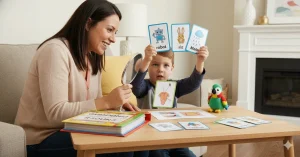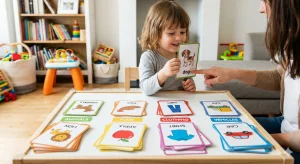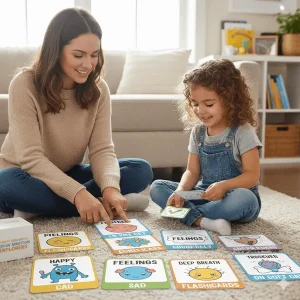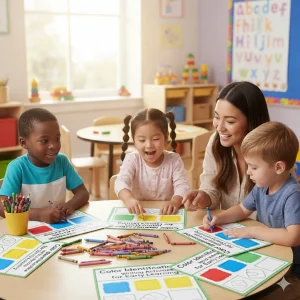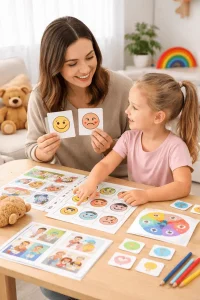How Storytelling Boosts Speech and Language Skills in Children
By Rajini D
Last Updated: December 19, 2024
Welcome to the enchanting world of storytelling—a key tool in enhancing your child’s speech and language skills. Each story your child hears enriches their vocabulary, improves listening abilities, and nurtures an understanding of language structure. In early childhood, where brain development is rapid, storytelling not only entertains but also lays a crucial foundation for communication and educational success. Let’s explore how integrating stories into daily routines can spark a lifelong love for learning and effectively support your child’s developmental journey.
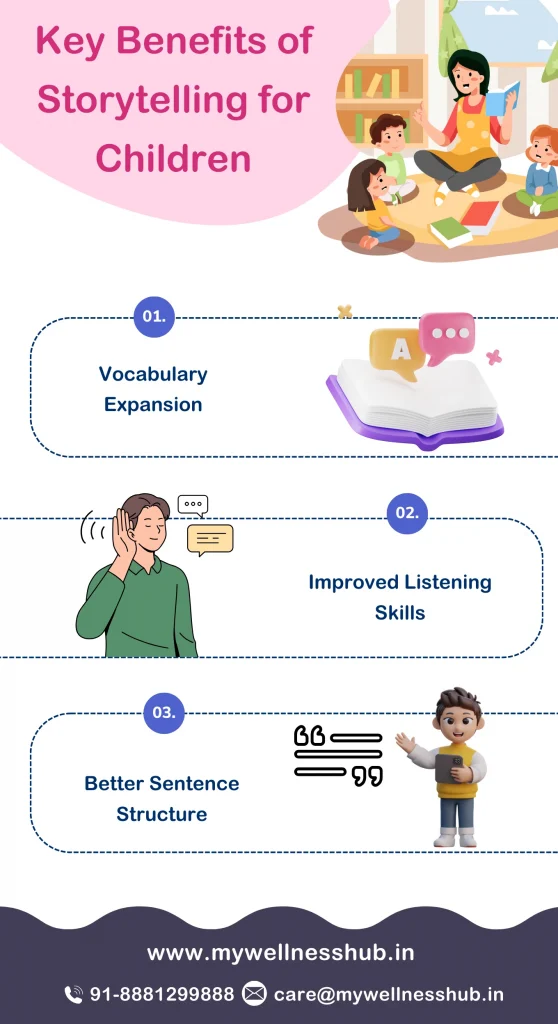
Read More: Enhance Child Language Development: Guide for Parents
The Science Behind Storytelling and Language Acquisition
1. Understanding How Storytelling Supports Learning
Storytelling is more than just sharing tales; it’s a powerful tool that helps children understand and use language. When kids listen to stories, they learn how words form sentences and express ideas. This listening helps them develop their own speaking skills.
2. Benefits of Storytelling for Speech and Language
Hearing different words and sentences in stories helps children learn new vocabulary and grasp language rules. As they listen, they practice the sounds and rhythms of speech, which is essential for their own speech development.
3. Enhancing Vocabulary Through Storytelling
Introducing New Words
Stories are great for learning new words. For instance, a tale about a zoo might include words like “elephant,” “cage,” or “zookeeper.” These new words are introduced in an engaging context, making them easier to remember.
Tips for Parents
- Pick stories with rich language: Choose books that have interesting words and phrases.
- Talk about the story: After reading, discuss the story and explain any new words.
- Encourage your child to retell the story: This helps them use new vocabulary actively.
4. Boosting Listening and Comprehension Skills
How Storytelling Helps Listening
Listening to stories helps children develop attention to spoken language, improving both memory and understanding.
Tips to Improve Comprehension
- Interactive reading: Pause while reading to ask your child what they think will happen next or why a character acted a certain way.
- Use visuals: Show pictures or use objects related to the story to help explain the story better.
- Regular storytelling: Consistently reading stories will strengthen your child’s language skills over time.
Practical Storytelling Techniques for Parents
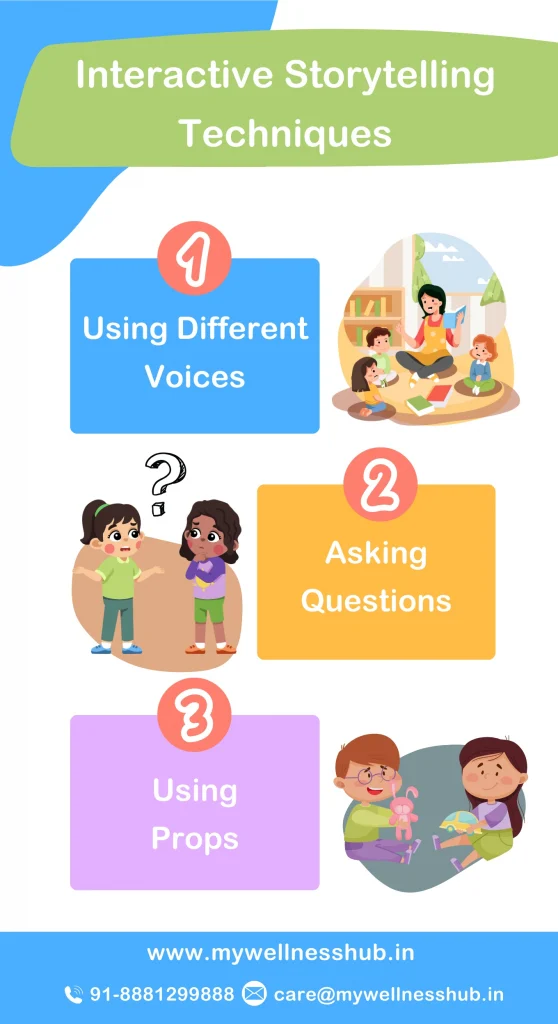
Choosing Stories for Different Ages
Select stories based on your child’s age:
- Toddlers (1-3 years): Pick books with simple texts and bright pictures to help connect words to images.
- Preschoolers (4-5 years): Choose stories with simple plots to introduce them to storytelling structure.
- Older Children (6+ years): Opt for stories with complex plots and character development to boost critical thinking and comprehension.
Interactive Storytelling Methods
Keep your child engaged by:
- Asking questions: Pause to ask what might happen next, encouraging them to think and predict.
- Using different voices: Change your voice for different characters to make the reading lively and fun.
- Using props: Bring in toys or objects related to the story to make it interactive.
Making Storytelling Interactive and Fun
Incorporate Activities
Make story time active:
- Play related games: For a book about animals, make animal noises or have a mini-quiz about the characters.
- Crafts or drawing: After reading, do a related craft or drawing session to reinforce the story themes.
Use Expressions and Voice Modulations
Enhance the storytelling by:
- Expressing emotions: Use your face and hands to express emotions in the story.
- Modulating your voice: Adjust your volume and tone to fit the scene, which helps convey emotion and keeps the story engaging.
Interactive Storytelling Techniques and Their Benefits
| Technique | Description | Benefits for Speech Development |
|---|---|---|
| Using Different Voices | Change voice tone and pitch to match different characters, making the story dynamic and engaging. | Enhances language differentiation and listening skills. |
| Asking Questions | Pose questions about the story to encourage critical thinking and interaction. | Improves comprehension and critical thinking. |
| Using Props | Utilize physical items like puppets or hats related to the story to add a visual element. | Aids in visualization and sensory experience, enhancing narrative understanding. |
Storytelling as a Tool for Speech Therapy
Using Storytelling in Speech Therapy
Storytelling is a fun and effective way to engage children in speech therapy. Therapists often use stories to practice sounds and words that children find difficult. This method keeps therapy enjoyable and engaging, helping children practice speech without feeling pressured.
Benefits for Children with Speech Delays
- Keeps Children Engaged: Stories capture children’s interest, making speech practice more enjoyable.
- Improves Understanding: Listening to and telling stories enhances children’s understanding of language.
- Boosts Memory: Regular storytelling helps children remember new words and phrases.
- Builds Confidence: Successfully using language in stories can increase a child’s confidence in their speaking abilities.
Incorporating Storytelling into Daily Routines
Making Storytelling a Daily Habit
Integrating storytelling into your daily routine can enrich your child’s language skills and strengthen your bond. To make storytelling a regular part of your day, consider setting aside a specific time for it, such as after dinner or before bedtime. These moments when the family naturally comes together provide a perfect opportunity to share stories and discuss the events of the day.
Choosing the Best Times and Settings
- Bedtime: This classic storytelling time helps children wind down for the night and is a great way for families to connect before sleep.
- Mealtime: Sharing stories around the dinner table can make mealtime more enjoyable and encourage family discussions.
- During Drives: Long drives can be an excellent opportunity for storytelling, keeping children engaged and making the journey feel shorter.
Creating an Ideal Storytelling Environment
Setting plays a crucial role in making storytelling an immersive experience. Here are a few tips to create the perfect storytelling environment:
- Comfortable setting: Make sure everyone is comfortable. Gather around on the couch or sit on the floor with cushions.
- Minimize distractions: Turn off TVs and put away electronic devices to ensure everyone is focused on the story.
- Interactive space: Allow room for children to act out parts of the story or use props.
About Wellness Hub
Your Partner in Child Development
Welcome to Wellness Hub, where we are dedicated to supporting your child’s growth and development through expert resources and tailored services. At Wellness Hub, we understand the critical role that communication plays in early childhood development, and we are committed to providing parents and educators with tools to foster these essential skills.
Services and Resources for Speech and Language Development
At Wellness Hub, we offer a comprehensive range of services designed to support speech and language development:
- Therapeutic Tools and Activities: Our carefully curated resources include interactive tools and activities that make learning fun and engaging for children while promoting speech and language skills.
- Expert Guidance: We collaborate with experienced speech-language pathologists who provide insights and strategies tailored to meet the individual needs of each child.
- Online Workshops and Webinars: To equip parents and educators with the necessary skills, we regularly host workshops and webinars that cover various aspects of speech and language development.
- Customizable Learning Plans: Understanding that each child is unique, we offer personalized learning plans that cater to the specific developmental needs of your child, ensuring they receive the most effective support.
Conclusion
Storytelling is a simple, powerful way to boost your child’s speech and language development. Through fun and engaging stories, children learn new words, improve their listening skills, and practice speaking clearly. We encourage parents to make storytelling a daily habit—it’s not just entertaining, it’s educational. Start with a bedtime story tonight, and soon, you’ll see a big difference in your child’s communication abilities. For more storytelling tips and resources, visit Wellness Hub. Let’s turn every story into a stepping stone for your child’s success!
Frequently Asked Questions:
1. Why is storytelling important for children’s speech development?
Storytelling plays a crucial role in speech development by introducing children to new vocabulary and helping them understand how sentences are structured. This exposure enhances their ability to communicate by expanding their language use and comprehension. The narrative context of stories makes it easier for children to remember and use new words and phrases.
2. How often should I read stories to my child to improve their language skills?
Integrating storytelling into your daily routine is highly beneficial. Reading to your child every day, especially during routine times like before bed or during meals, provides consistent exposure to language and helps reinforce learning. The regular practice helps deepen their understanding and use of language over time.
3. What types of stories are best for improving speech in young children?
For young children, stories that are simple, rhythmic, and repetitive work best as they help with memorization and ease of understanding. Books with clear and vivid pictures also help children connect words with images, enhancing their vocabulary and comprehension.
4. Can storytelling help my toddler start talking?
Yes, storytelling can be very effective in encouraging toddlers to start talking. Engaging them with stories that involve simple, repetitive phrases allows them to hear and practice essential sounds and words, fostering their ability to form their own words and sentences.
5. How can storytelling aid in my preschooler’s language learning?
For preschoolers, storytelling helps by exposing them to a broader range of vocabulary and more complex sentence structures. This age group benefits from stories that challenge them slightly but still hold their interest with engaging plots and characters.
6. What are the best times to incorporate storytelling into our routine?
Consistency is key in making storytelling a beneficial part of language learning. Bedtime and mealtime provide natural, daily opportunities to engage with your child through stories. These times are usually free from distractions, allowing your child to focus on the story and the language.
7. Are digital stories as effective as reading books for speech development?
Digital stories can also be effective, especially if they are interactive. Interactive ebooks or apps that prompt children to engage with the content can be just as beneficial as traditional books, provided they encourage active participation and not passive consumption.
8. How can I make storytelling more engaging for my child?
To keep your child engaged, vary your voice to match different characters and use plenty of expressions and gestures. Encouraging your child to predict what will happen next or to act out parts of the story can also make storytelling more interactive and fun.
9. What should I do if my child loses interest in a story?
If your child starts to lose interest, it might be time to switch to shorter stories or those with more interactive elements. Books with flaps to lift or textures to feel can also keep small children engaged. Ensuring the stories match their interests is key—whether it’s dinosaurs, space, or fairy tales.
10. Where can I find resources to help me choose the best books for storytelling?
For a curated list of books ideal for developing speech and language skills, visit platforms like Wellness Hub or consult resources at your local library. These sources often have lists segmented by age group and developmental stage, helping you choose books that are most appropriate and engaging for your child’s current needs.
About the Author:
Rajini Darugupally
M.Sc., Speech-Language Pathologist (9+ years of experience)
Rajini is a passionate and dedicated Speech-Language Pathologist with over 9+ years of experience, specializing in both developmental speech and language disorders in children and rehabilitation in adults. Currently, at Wellness Hub, she thrives in a team environment that values innovation, compassion, and achieving results for their clients.
Book your Free Consultation Today
Parent/Caregiver Info:
Client’s Details:
* Error Message

